 Image search results - "tsukiji" Image search results - "tsukiji" |

Established in 1617, Tsukiji Hongwanji temple is the Tokyo headquarters of the Nishi Hongwanji Jodo Shinshu sect. The present temple, based on Indian architecture, was built in the 1930s.The temple is the only one in Japan which is under the direct control of the sect. Its head priest is the Monshu Abbot himself. April 8 is observed as Buddha's birthday, called Hana Matsuri ("Flower Festival) in Japan.
|
|

Tsukiji Hongwanji temple gate with wisteria crest.The emblem is a wisteria flower and symbol of the Jodo Shinshu sect.
|
|

Temple gate and flag
|
|

Play room for kids on Hanamatsuri
|
|

Hanamatsuri altar
|
|

Pouring sweet tea over the BuddhaWhen the Buddha was born in Lumbini Garden in Nepal, sweet rain is said to have fallen. Thus, sweet tea is poured over the baby Buddha statue in the Hanamatsuri altar.
|
|

Hanamatsuri celebrates the Buddha's birthday on April 8. This is Tsukiji Honganji in Tokyo.The flowers symbolize Lumbini Garden where the Buddha was born in present-day Nepal.
|
|

Baby Buddha statueLadles are provided for pouring the sweet tea over the Buddha. Sweet tea is also provided to worshippers. It symbolizes the sweet rain that fell when the Buddha was born.
|
|

Children dressed for the chigo parade, Tsukiji Hongwanji, TokyoIt took a long time before they could get all the kids to settle down for the picture and to get all the mothers out of the picture.
|
|

Children dressed for the chigo parade (photo session), Tsukiji Hongwanji, Tokyo
|
|

Going to the chigo parade's starting point
|
|

White elephant to anchor the parade. Notice the Buddha altar riding on the top. Before she gave birth to the Buddha, Queen Maya dreamed of a white elephant.
|
|

Start of the Hanamatsuri parade which also promotes traffic safety.The starting point was a nearby park.
|
|

Parade starts...
|
|

Baton-twirling club from the Chiyoda Jogakuin Junior/Senior High School followed by the elephant千代田女学院
|
|

Chigo children
|
|

On the road in front of the temple
|
|

Baton-twirling club, Tsukiji Hongwanji, Tokyo 千代田女学院 バトン部千代田女学院
|
|

Female schoolmates of the baton twirlers block the cameras of unrelated photographers when the baton twirlers passed. カメラ小僧を妨害するバトン部の先輩たち。This was the first time for me in Japan to see people blocking photographers from taking pictures at a festival. They did it to me as well. If they don't want to be photographed, why do they appear in this public festival??
妨害しても無駄だと思いますが。撮られるのがいやでしたら、まつりに出ない方がいいですよ。
|
|

Band from the Chiyoda Jogakuin Girls Junior/Senior High SchoolNo problem photographing them.
|
|

The elephant follows the band.
|
|

Entering the temple gate
|
|

Final performance
|
|

The parade was over after 30 min. (11:30 - 12 pm).
|
|

Chigo kids enter the temple
|
|

Hanamatsuri service inside the templeNotice the Hanamatsuri altar at the center.
|
|

Hanamatsuri service inside the Tsukiji Hongwanji temple
|
|

Hanami-do housing a statue of the baby Buddha on which sweet tea is poured. When the Buddha was born in Lumbini Garden, flowers bloomed.
|
|

Praying to the Hanamatsuri altar
|
|

Pipe organs
|
|

Outdoor food court
|
|

Statue of St. Shinran, founder of Jodo Shinshu sect.
|
|

Statue of St. Shinran (1173-1263), founder of the Jodo Shinshu (Pure Land) Buddhist Sect.
|
|

Cherry blossoms and the temple
|
|
|
|

Playroom for kids
|
|

Temple hall exterior
|
|

The white elephant
|
|
|

Taiko drum performance by Oedo Sukeroku Taiko troupe. 大江戸助六太鼓Their Web site: http://www.oedosukerokutaiko.com/
大江戸助六太鼓
|
|

Oedo Sukeroku Taiko troupe大江戸助六太鼓
|
|

Oedo Sukeroku Taiko troupe. They were all girls and super good!大江戸助六太鼓
|
|

Oedo Sukeroku Taiko troupe大江戸助六太鼓
|
|

Oedo Sukeroku Taiko troupe
|
|

Beating backward: Oedo Sukeroku Taiko drummers大江戸助六太鼓
|
|

Hanamatsuri in the old days (lot more children and people). 昔の築地本願寺の花まつり: 子供の数が大多かった。
|
|
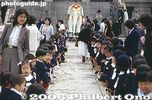
Many little kids held a long rope to pull the white elephant. 昔の築地本願寺の花まつり
|
|

Chigo children. They have two black dots on the forehead and a white stripe on the nose. They don't paint the white stripe today. 昔の築地本願寺の花まつり: 鼻に白い線が塗っている。今は、塗らない。
|
|

Chigo children. 昔の築地本願寺の花まつり
|
|
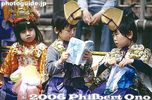
Chigo children. 昔の築地本願寺の花まつり
|
|

Chigo children. 昔の築地本願寺の花まつり
|
|

昔の築地本願寺の花まつり
|
|
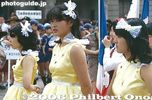
昔の築地本願寺の花まつり: 日大のバトン部か
|
|
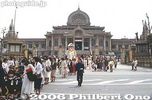
A very long hanamatsuri parade leaves the temple. 昔の築地本願寺の花まつり: 集合は別院内、これは出発。
|
|
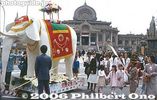
昔の築地本願寺の花まつり
|
|

Look at all those Cub Scouts. They don't participate today. 昔の築地本願寺の花まつり
|
|
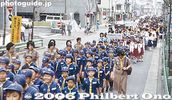
The chigo parade of bygone days was much longer with a lot more kids. 昔の築地本願寺の花まつり: かなり長い行列でした。
|
|

Buddhist flag. 昔の築地本願寺の花まつり
|
|

Nihon University college band was part of the parade. 昔の築地本願寺の花まつり
|
|

昔の築地本願寺の花まつり
|
|
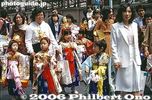
昔の築地本願寺の花まつり
|
|
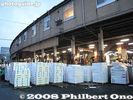
Officially called the Tokyo Metropolitan Central Wholesale Market, this sprawling complex handles mainly fish, but also fruits and vegetables. This is outside the market building.Update: Tsukiji Fish Market closed on Oct. 6, 2018 since it moved to Toyosu. These pictures were taken when toursts were still free to roam around the auction area and inner market. Now a blast from the past. Sorry you missed it.
|
|
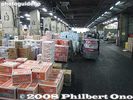
The market is near Tsukijishijō Station on the Toei Ōedo Line and Tsukiji Station on the Tokyo Metro Hibiya Line. The first subway arrives at around 5:20 am. First you walk through the fruit section..
|
|

Fruit section.
|
|

Watch out for these speeding trolleys. They are almost everywhere.
|
|
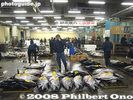
There is no map of the place so you may or may not find the tuna auctions. It's also easy to get lost in the market. This is the fresh fish tuna storage area.
|
|
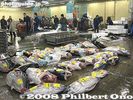
Never saw this much tuna in my life.
|
|
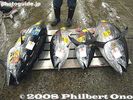
These fish can be huge, bigger and heavier than a sumo wrestler.
|
|
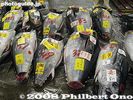
All the fish are labeled. They might indicate where the fish was caught (or raised).
|
|
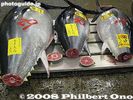
Tails are cut off to show the flesh color.
|
|
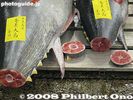
Buyers check the color of the flesh to determine how fatty the fish is.
|
|
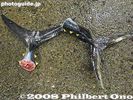
Cut-off tails
|
|
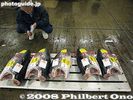
Headless tuna carcasses
|
|
|

Tuna head
|
|
|
|

The market building has many signs of its old age.
|
|
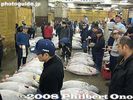
Frozen tuna auctions at Tsukiji Fish Market.
|
|
|
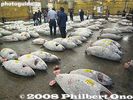
Frozen tuna anyone?
|
|
|
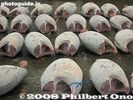
Headless frozen tuna.
|
|
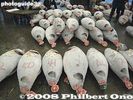
These frozen fish did not show any signs of melting. Wonder how long it takes for them to defrost.
|
|
|
|
|
|
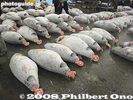
Each fish is worth thousands or tens of thousands of US dollars.
|
|

Looks good to me.
|
|
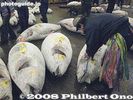
Tying a ribbon on fish.
|
|
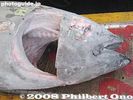
Frozen tuna head
|
|
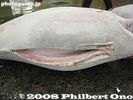
Tuna belly, the fatty part of the fish for toro sashimi.
|
|
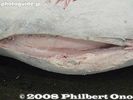
Looks yummy.
|
|
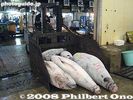
After the auctions are over, they haul out the fish using a variety methods.
|
|
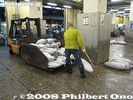
Hauling these tuna on this lift looked easy.
|
|
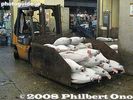
All full and ready to go. Gee, how much is all that tuna worth??
|
|
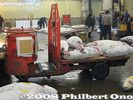
Smaller trolley for a smaller haul.
|
|
|

Hand-drawn cart.
|
|
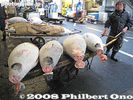
Hand-drawn cart, good for four fish.
|
|
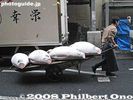
Good exercise in the morning.
|
|
|
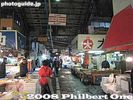
The fish is taken to the fish stalls in the market.
|
|
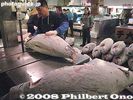
The frozen tuna is cut up into quarters lengthwise by a band saw.
|
|
|
|
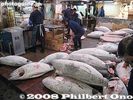
Quite a few more to cut up.
|
|
|

After the fish is cut, they shave it with an ax.
|
|

Cutting up a fresh fish. They use a long, sharp knife, and not a band saw.
|
|

Tuna knives
|
|
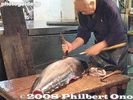
I wonder how long it takes to be able to cut up a giant tuna.
|
|
|
|
|
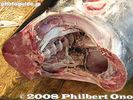
Where the head was attached.
|
|

The fresh tuna is cut up into smaller blocks.
|
|

This size is easy to sell to mom and pop sushi restaurants.
|
|
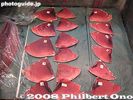
Fresh tuna
|
|
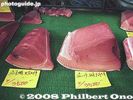
Caught in the Pacific Ocean.
|
|

The tuna flesh between the rib-like bones is also choice meat. It is scraped off with a spoon.
|
|
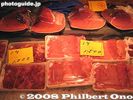
Packaged to sell.
|
|

The huge fish market consists of rows and rows of fish monger stalls, divided by narrow aisles.
|
|
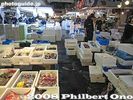
Styrofoam and plastic cartons contain all kinds of fish.
|
|
|

Fish waiting to be decapitated.
|
|
|
|
|

OK, which one's next?
|
|
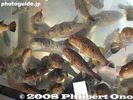
Puffer fish swim happily, ignorant of their ultimate fate.
|
|
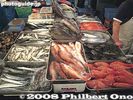
Fish and more fish...
|
|
|
|
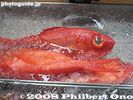
Fish in ice
|
|
|
|
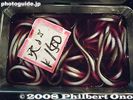
Eels
|
|

Sea urchin (uni), one of my favorites.
|
|

Oysters
|
|
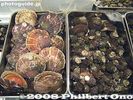
Shellfish
|
|

Sea urchins
|
|
|
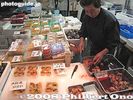
Shellfish
|
|
|
|

Squid in black ink
|
|

Octopi
|
|

Tako
|
|

Shrimp
|
|
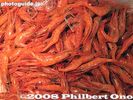
Prawns
|
|
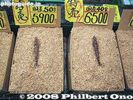
Prawns
|
|
|

Frozen crab
|
|
|
|
|
|
|